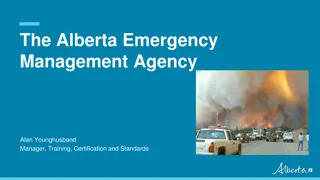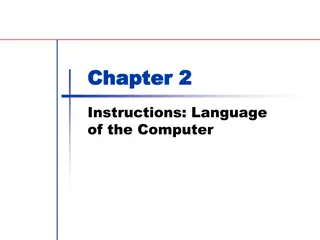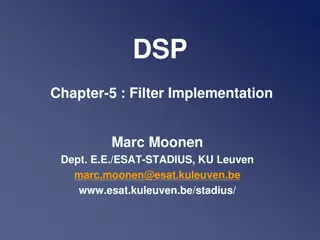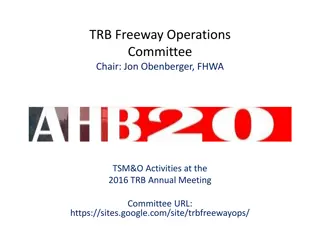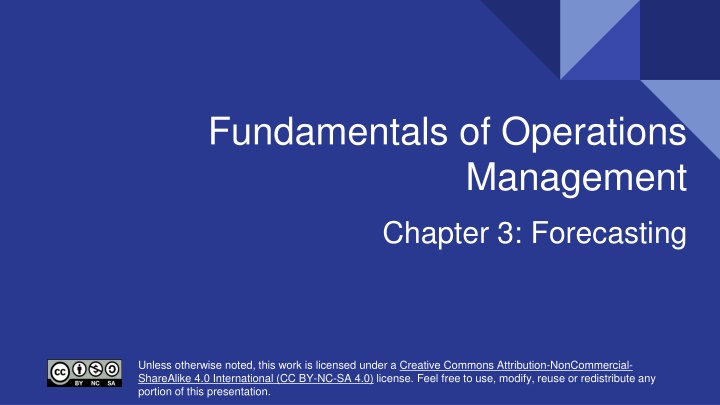
Forecasting in Operations Management
Learn the importance of forecasting in business success, how to calculate forecasts, and the consequences of inaccurate predictions. Explore different forecasting methods, such as qualitative and quantitative approaches, and understand the role of forecasting in marketing strategy implementation. Discover how forecasting helps businesses anticipate market changes, manage uncertainty, and plan for future events effectively.
Download Presentation

Please find below an Image/Link to download the presentation.
The content on the website is provided AS IS for your information and personal use only. It may not be sold, licensed, or shared on other websites without obtaining consent from the author. If you encounter any issues during the download, it is possible that the publisher has removed the file from their server.
You are allowed to download the files provided on this website for personal or commercial use, subject to the condition that they are used lawfully. All files are the property of their respective owners.
The content on the website is provided AS IS for your information and personal use only. It may not be sold, licensed, or shared on other websites without obtaining consent from the author.
E N D
Presentation Transcript
Fundamentals of Operations Management Chapter 3: Forecasting Creative Commons Attribution-NonCommercial-ShareAlike 4.0 International (CC BY-NC-SA 4.0) Creative Commons Attribution-NonCommercial-ShareAlike 4.0 International (CC BY-NC-SA 4.0) Unless otherwise noted, this work is licensed under a Creative Commons Attribution-NonCommercial- ShareAlike 4.0 International (CC BY-NC-SA 4.0) license. Feel free to use, modify, reuse or redistribute any portion of this presentation.
3.0 Learning Outcomes In this chapter, we will: Define forecasting and differentiate it from related concepts such as prediction. Describe the role of forecasting in marketing strategy implementation. Outline the differences between qualitative and quantitative forecasting methods. Perform forecast calculations such as simple moving averages, weighted moving averages, and exponential smoothing. Use associative/causal methods of forecasting for operational decision- making. Calculate forecasts using time series analysis and seasonal index. Calculate Mean Absolute Deviation (MAD), Mean Squared Error (MSE), and Mean Absolute Percentage Error (MAPE) to assess forecast accuracy.
3.1 Going With the Flow for Business Success Customers, competitors, suppliers, and government are identified as the four key players in the modern business environment. Economic, technological, and social forces can change the market climate, affecting these key players. Customers are the most prominent players for profit-seeking firms. Climate change leads to changing marketplace requirements, making customer preferences more diverse and ambiguous. The market may differ in the future due to these dynamic changes. To remain competitive, businesses must adapt to changes and anticipate future market conditions. Forecasting is a tool businesses use to foresee and adapt to potential changes in the market. Forecasting is determining future events by analyzing past and current data. It helps businesses manage uncertainty and plan for anticipated events and expenses.
3.2 Role of Forecasting in Marketing Strategy Forecasting is essential for marketing strategy implementation and aligning marketing with corporate strategy. Methods Formal statistical methods: time series, cross-sectional, or longitudinal data. Additionally, informal judgmental methods may be used. Terminology varies by discipline (e.g., forecast vs. prediction in hydrology). Uncertainty and Risk Inherent in forecasting and prediction. Best practices require communicating the extent of uncertainty. Data accuracy is critical for reliable forecasts. Sales Forecasting Estimates a company s future sales volume. Acts as a benchmark for production, inventory management, and resource allocation. Accuracy is crucial to avoid overestimation or underestimation of product demand.
3.2 Forecasting in Marketing Strategy (cont.) Consequences of Inaccurate Forecasts Overestimating demand leads to wasted expenditures on unused manufacturing and distribution. Underestimating demand allows competitors to capture unmet market needs. Elements of a Sales Forecast More than anticipated sales figures; includes factors like pricing strategy and competitor actions. Dynamic and constantly evolving with changing variables. Market Potential and Sales Potential Market potential: total projected industry-wide sales for a product category. Sales potential: maximum anticipated revenue or unit sales for the company, expressed as a percentage of market potential. Helps compare projected revenue against market potential and product costs.
3.3 Forecasting Horizons and Their Applications Forecast Timeframe Scope Method Applications Long-Term (LT) Exceeds two years. Strategic level decisions. Expert judgment, scenario planning. New product launches, emerging technologies, new facilities. Medium-Term (MT) Several months to two years. Tactical decision- making. Quantitative and qualitative forecasting. Strategic initiatives, operational planning. Short-Term (ST) Daily to a few months. Operational decision- making. Quantitative methods, particularly time series analysis. Inventory management, production scheduling, workforce allocation.
3.4 Types of Forecasts Technological Forecasts: Demand Forecasts (Sales Forecasts): Economic Forecasts: Predict economic indicators like housing starts, inflation rates, and money supply. Help organizations anticipate and plan for broader economic conditions. Impact overall business cycle and organizational operations. Monitor rates of technological progress and trends. Keep organizations updated on emerging technologies. Plan for new products, processes, services, facilities, equipment, or infrastructure. Estimate future consumer demand for products or services. Drive critical operational planning decisions. Affect production scheduling, capacity planning, inventory management, financial planning, workforce planning, and marketing strategies.
3.5 Categories of Forecasting Methods Qualitative Forecasting: Quantitative Forecasting: Executive Judgement (Top Down): Uses high- level executives' expertise to analyze market data and trends for consensus forecasts. Sales Force Opinions (Bottom-up): Aggregates forecasts from sales personnel based on direct customer interaction. Delphi Method: Utilizes anonymous expert surveys to iteratively refine and reach consensus forecasts. Market Surveys: Employs market research firms to gather consumer sentiment and future purchasing intentions. Associative Models: Uses relationships between variables to forecast future data. Linear Regression: Predicts future values using a linear relationship between two variables. Multiple Linear Regression: Extends linear regression to multiple variables to predict future values. Na ve: Uses the last period's demand as the forecast for the next period. Simple Moving Average: Averages a fixed number of past periods to smooth out short-term fluctuations. Exponential Smoothing: Applies decreasing weights to past data for smoothing and forecasting. Trend Projection Model: Uses historical data trends to project future values.
3.6 Associative Models/Causal Forecasting Associative model forecasting, also known as causal or econometric forecasting, uses quantitative techniques to predict future values by analyzing relationships with other variables. Methodology: Unlike time-series methods, it considers multiple independent (causal) variables influencing the forecasted dependent variable, establishing cause-and-effect relationships. Enhancing Accuracy: Incorporating explanatory variables, like climate data for umbrella sales, improves forecast accuracy. Seasonal variations, such as holidays or cultural customs, are also factored in. Key Considerations: Ensure the validity of assumptions, data quality, and proper selection and evaluation of forecasting models to make informed decisions in operations management. Applications: Demand Forecasting: Predicts product/service demand. Capacity Planning: Estimates required production capacity. Inventory Management: Forecasts inventory levels. Resource Allocation: Optimizes resource use. Supply Chain Management: Predicts supply chain performance.
3.6 Regression Analysis Definition: Regression analysis is an associative forecasting method that constructs a mathematical equation relating a dependent variable to one or more independent variables. Purpose: It estimates the relationships between variables, helping to understand how changes in independent variables impact the average value of the dependent variable. Function: The coefficients in the regression equation indicate the magnitude and direction of the independent variables impact on the dependent variable. Figure 3.6.1: Example of regression analysis. The data points follow an upward trend, indicating a positive correlation between the variables. The linear regression line slopes upward from left to right, suggesting a strong linear relationship.
3.6 Correlation Analysis Correlation analysis is often used with regression analysis to measure the strength and direction of the linear relationship between the dependent and independent variables. The correlation coefficient, denoted by r, ranges from -1 to 1, with values closer to 1 or -1 indicating a stronger linear relationship and values closer to 0 indicating a weaker or no linear relationship. Figure 3.6.2 Correlation based on direction, form, and dispersion strength (Sunil Kumar, 2018)
3.7 Time Series Models Essential for forecasting, time series data captures trends and patterns over time and is used across various disciplines. Interval selection is crucial for accuracy with optimal intervals impacting data fluctuations. Terms like "short-term," "medium-term," and "long-term" are relative and context-dependent. Time Period Data Pattern Forecasting Technique Short term: less than 3 months Data does not show any particular pattern or variation Simple Moving Average Weightedmoving average Exponential Smoothing Medium-term: 3 months to two years Data either repeats periodically or moves in a particular direction, i.e. upward or downward. Seasonal and Trend Variation Long-term: more than 2 years Data shows a repeated pattern but at irregular intervals with irregular intensity. Cyclical method
3.7 Trend Analysis Trend: Represents a consistent upward or downward movement in data over time, influenced by the product life cycle. Cyclical: Characterized by recurring fluctuations in data over periods longer than a year, influenced by factors like interest rates and political climates. Seasonal: Exhibits predictable annual changes in demand, as seen with products like winter coats and swimwear. Figure 3.7.1: Diagram of trend, cyclical, and seasonal demand patterns. Irregular variations: Unpredictable fluctuations in demand caused by unforeseen events such as extreme weather or labor strikes. Random variations: Unexplained fluctuations in demand, representing inherent noise in time series data.
3.7 Time Series Models: Methods Na ve Method Forecasts future values by using the previous period's actual value, assuming future values will match the most recent observed value. Advantages: Easy to implement, suitable for stable demand. Disadvantages: It ignores patterns and trends and is unsuitable for new products/services. Exponential Smoothing Combines recent actual demand and previous forecasts, with a smoothing coefficient Alpha ( ) determining responsiveness to demand changes. Advantages: More accurate, adaptable to new trends. Disadvantages: Requires proper selection of and initial forecast assumptions. Simple Moving Average Calculates the average of data points from the most recent n periods for future forecasts, with the choice of n being crucial. Advantages: Simple and easy to compute. Disadvantages: May not capture recent trends or shifts due to equal weighting of data point Seasonal Index Quantifies recurring seasonal patterns by comparing specific period demand to average demand, adjusting forecasts accordingly. Useful for products with recurring seasonal demand patterns, helps plan inventory, staffing, and promotions aligned with seasonal fluctuations.
3.8 Forecast Accuracy Measures Mean Squared Error (MSE): Mean Absolute Percentage Error (MAPE): Expresses forecast errors as a percentage of the actual values. It is useful for comparing data on different scales but can be problematic with actual values close to zero. Mean Absolute Deviation (MAD): Squares the forecast errors before averaging them, giving more weight to larger errors. It is the average of the squared differences between forecasted and actual values, making it sensitive to outliers. Measures the average magnitude of forecast errors without considering direction. It is the mean of the absolute differences between forecasted and actual values. A lower MAD indicates better forecast accuracy.
Summary & Review Forecasting Role: Essential in business, particularly for implementing marketing strategies, by predicting future trends using historical and current data. Methodologies: Combines formal statistical methods and judgmental approaches to help businesses anticipate and adapt to market changes. Sales Forecasting: Critical for aligning marketing strategies with corporate goals, guiding production, inventory management, and resource allocation. Accuracy Importance: Accurate forecasts prevent financial repercussions from overestimating or underestimating product demand. Types of Forecasts: Covers economic, technological, and demand forecasts, each crucial for operations management. Forecasting Methods: Includes qualitative and quantitative techniques such as executive judgment, market surveys, regression analysis, and time series analysis, chosen based on data availability and forecasting needs.


